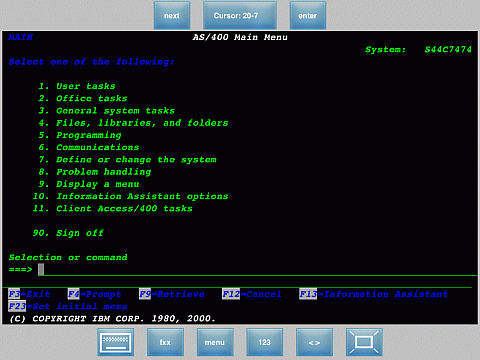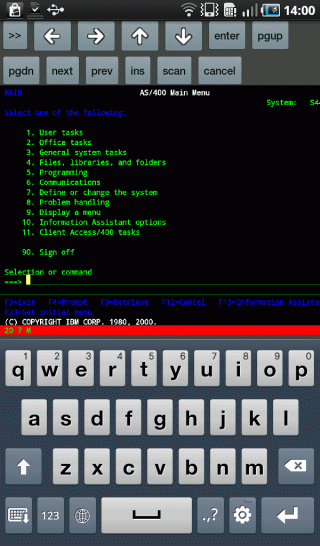Take advantage of tablet-based devices in a System i world.
According to a USA Today article from December of 2010, 21 million tablet PCs were sold in 2010. Most of those sales were as a result of Apple's introduction of the iPad. Tablet devices like the Apple iPad are often thought of as high-tech "toys" used for simple tasks like playing games, sending email, Web surfing, or maybe watching a movie or listening to music. But the real power of these devices that's often overlooked is the potential of using them as business tools. Specifically, I believe these devices are well-suited for use in the System i world. This article explores a few of the options for using tablets with the System i.
Business Connectivity
Perhaps one of the most important aspects of using any of these devices for viable business use is actually connectivity to your business network. If the intention is to use these devices inside of the physical confines of your company's wireless network, then you're all set. If, however, you need to connect from a remote location—like your home or a hotel room or airport—while travelling, then you'll need to ensure that the device you choose is capable of client connectivity to your company's VPN. If your company uses a Cisco VPN, you'll most likely have no problem connecting to your business LAN from any of these devices. Several of these devices, including the Apple iPad, have a built-in Cisco VPN client. Others—like those based on Windows 7.0 or Ubuntu/Linux operating systems—have the capability of running the existing Cisco VPN clients available for those operating systems. The table below details the VPN connectivity options for several popular tablet platforms.
|
VPN Connectivity Options for Tablets |
||||
|
Tablet Platform |
SSL VPN (Certificate/ Token- Based) |
CISCO IPSec |
L2TP Over IPSec |
Point-to-Point Tunneling Protocol (PPTP) |
|
Apple iPad |
Native |
Native |
Native |
Native |
|
Android-Based (Motorola Xoom, etc.) |
No/Third Party |
No/Third Party |
Native |
Native |
|
Windows 7-Based (Asus Eee EP121) |
Third Party |
Cisco Client |
Native |
Native |
|
Ubuntu/Linux-Based (RealEase ShoGo) |
Open Source |
Open Source |
Open Source |
Open Source |
You'll notice that most of the tablets currently available support some form of VPN connectivity. Your selection may pivot on the type of VPN utilized by your business.
System i Connectivity
Connectivity from any of these devices to your System i can be done through a variety of methods. For basic connectivity, the primary option you would want to make sure you have is a TN5250-compatible Telnet client. Both the iPad and Android-based devices can support this via the MochaSoft TN5250 software (see Figures 1 and 2).

Figure 1: This is the iPad version of MochaSoft's TN5250 Client.

Figure 2: This is the Android version of MochaSoft's TN5250 Client.
It's worth noting that both the iPad and Android TN5250 Clients by MochaSoft allow the use of the device's camera as a barcode scanner. This could allow you to enable either of these devices in an inventory control environment or a retail environment. These devices can support the standard System i Access for Windows client, which makes a Windows 7-based tablet a great option if you want to run the same application that's used on your company's desktops.
There are several options available for Ubuntu/Linux-based tablets, but these devices are in their infancy and can be difficult to find. If, however, you're an Ubuntu junkie like me, you'll know that the Ubuntu Unity desktop lends itself greatly to a tablet device. MochaSoft makes a version of the TN5250 client that runs on Linux, and there's also a version of System i Access for Linux.
Another good option for both Windows 7- and Ubuntu-based devices would be the TN5250J project. This open-source project offers a very full-featured Telnet 5250-compatible client with features you would expect, like hot spots, along with added functionality, like file transfer capability and spooled file export directly from the client.
On the client Telnet emulation side, it's clear that each of these devices gives some level of System i access capability.
Database Connectivity
If you want higher-level access to your System i and need to develop apps running on the device that require database access directly to the System i, your options are numerous. Apple's iPad has several available products that will allow ODBC access...sort of. They achieve this through the use of a separate ODBC router, basically a PC server that routes the data from the database server to the tablet device. Several software products that allow you to develop apps using the Apple iOS SDK have this capability. Similar technology exists in the Android world. A better option for both of these might be to implement a Web service to provide the required data to your tablet app and then use the functionality supported natively by the device's SDK to consume that Web service. Once again, since Windows 7 and Ubuntu-based devices both run operating systems for which versions of System i Access exists, database connectivity to your System i can simply be achieved via the ODBC driver included with System i Access. Even in these cases, however, you might consider implementing a Web service because of the flexibility this would add to your tablet client choices.
Tablets for Business
No matter which of these devices you choose, it's plain to see that what were once considered simply high-tech "toys" are now becoming viable options as business devices. With more and more tablets hitting the market every day, tablets are here to stay. Hopefully, now you'll have some ideas for how to fit these devices into your business.
as/400, os/400, iseries, system i, i5/os, ibm i, power systems, 6.1, 7.1, V7, V6R1
















 Business users want new applications now. Market and regulatory pressures require faster application updates and delivery into production. Your IBM i developers may be approaching retirement, and you see no sure way to fill their positions with experienced developers. In addition, you may be caught between maintaining your existing applications and the uncertainty of moving to something new.
Business users want new applications now. Market and regulatory pressures require faster application updates and delivery into production. Your IBM i developers may be approaching retirement, and you see no sure way to fill their positions with experienced developers. In addition, you may be caught between maintaining your existing applications and the uncertainty of moving to something new. IT managers hoping to find new IBM i talent are discovering that the pool of experienced RPG programmers and operators or administrators with intimate knowledge of the operating system and the applications that run on it is small. This begs the question: How will you manage the platform that supports such a big part of your business? This guide offers strategies and software suggestions to help you plan IT staffing and resources and smooth the transition after your AS/400 talent retires. Read on to learn:
IT managers hoping to find new IBM i talent are discovering that the pool of experienced RPG programmers and operators or administrators with intimate knowledge of the operating system and the applications that run on it is small. This begs the question: How will you manage the platform that supports such a big part of your business? This guide offers strategies and software suggestions to help you plan IT staffing and resources and smooth the transition after your AS/400 talent retires. Read on to learn:
LATEST COMMENTS
MC Press Online